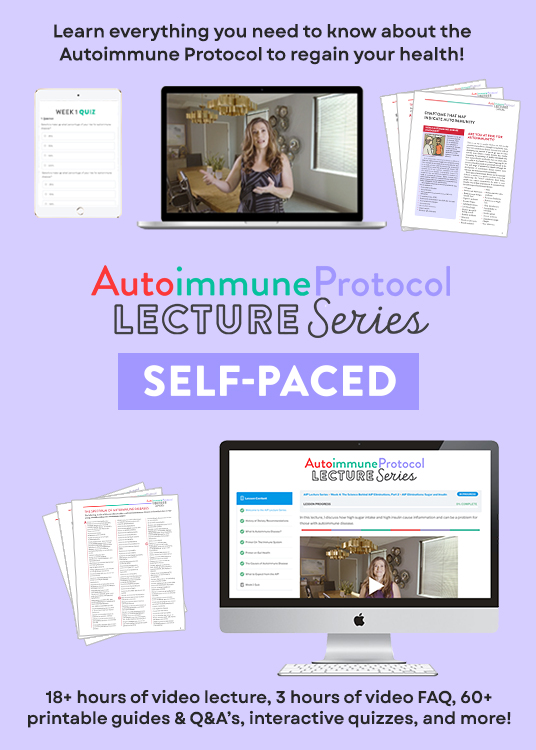Welcome to episode 403 of The Whole View! This week Stacy shares her personal experience with covid-19 and what they did as a family once Matt received a formal diagnosis. Hear about the timeline of symptoms their family experienced, and what they did to manage the daily changes. Plus, hear from Sarah on the latest updates from the scientific community.
Table of Contents[Hide][Show]
- The Whole View, Episode 403: Stacy Has Covid-19, Now What?
- This Week’s Sponsor
- The Toth-McCarry ‘s Have a Mild Case
- How Did We Get It?
- How Did Stacy Know?
- More on Symptoms
- Testing Experience
- Recommendations from the Doctor
- Answers & Explanations from Sarah
- Self-Care and Dealing with Symptoms
- When the Fatigue Hit
- Antibodies Testing
- Closing Thoughts
If you enjoy the show, please review it on iTunes!
The Whole View, Episode 403: Stacy Has Covid-19, Now What?
Welcome back to the Whole View, episode 403. (0:27)
It has been quite a journey since they last recorded.
Sarah is so glad that they prerecorded 402 because puppies are a lot of work.
It was also great timing for Stacy though because she could not have recorded an episode last week anyway.
Stacy slept for three days because she got covid-19.
She is recording this episode on day 13 and she is doing well and doesn’t want anyone to worry about her.
Huge thank you for the positive vibes.
You will notice throughout the recording that Stacy gets breathless from time to time and will need to slow down.
Stacy wants to share her experience with listeners.
Save 70% Off the AIP Lecture Series!
Learn everything you need to know about the Autoimmune Protocol to regain your health!
I am loving this AIP course and all the information I am receiving. The amount of work you have put into this is amazing and greatly, GREATLY, appreciated. Thank you so much. Taking this course gives me the knowledge I need to understand why my body is doing what it is doing and reinforces my determination to continue along this dietary path to heal it. Invaluable!
Carmen Maier

Thankfully for the information from this episode, this one, this one and this one, Stacy was relatively prepared.
She feels like she was able to manage it as best as she could for her family.
Her experience is in no way reflects what would be a medical recommendation.
This is simply Stacy giving her personal experience.
There is nothing they are going to cover that will prevent it, that will make a guarantee of a mild course for you, and is certainly not a cure.
However, what Stacy can do is share her experience so that you can relate to the information if you or someone around you contracts covid-19.
Sarah pointed out that we can know all the facts, but seeing the experience is very eye-opening.
This episode is going to be very experience focused.
Sarah will be sharing a bit of the updated science and a few points that we haven’t covered yet.
However, please be sure to revisit the four previous episodes (linked above) for the basic science.
This Week’s Sponsor
Before Stacy jumps into the experience, she wants to take a moment to thank this week’s sponsor, Just Thrive probiotics.
This is the brand of probiotics that both Stacy and Sarah personally take, and they have shared about them before.
You can find them at this link, and our code has been updated to ‘thewholeview’.
When you enter that code at checkout, you will receive 15% off your order.
Sarah has been taking Just Thrive for years.
They are very different from what you can find on grocery store shelves as they are soil-based organisms.
Thank you to Just Thrive for sponsoring this episode!
Stacy took advantage of their subscribe and save option partnered with the code.
The Toth-McCarry ‘s Have a Mild Case
So, first Stacy wants to say that both her and Matt are lucky for only getting mild cases.
There are a couple of reasons this could be the case.
This virus is known for taking a turn, which is a fear that Stacy has been heavily carrying.
The fear has been shared by her children.
Since Stacy and Matt are outside of the risk ages, Stacy feels fortunate.
Both Matt and Stacy are active and have a relatively healthy heart and lungs.
They focus on nutrient-sufficiency and an anti-inflammatory diet on a daily basis.
One of the decisions that they made beyond their daily diet was to not drink during the quarantine.
Stacy referred to this study on alcohol consumption and pneumonia.
The biggest reason that Stacy thinks they got so lucky is that Matt’s exposure was probably a low dose through a mailer, from touching an object.
As discussed in episode 401, Matt was reusing a mask and not washing it.
However, when that was recorded, they had likely already been exposed.
Since Stacy got sick so quickly after Matt did, it implies that Matt brought the virus home.
They were careful, but there is only so much you can do.
None of the steps that we take are perfect.
They reduce the risk of transmission, which is very important, but we know that this virus is ridiculously contagious.
Quite a few studies have confirmed that the exposure dose does dictate the severity of the course.
However, this is a complicated equation, impacted by other factors as well.
The more we implement the precautions, the more we increase our chances of a mild case.
There is nothing we can do but be diligent.
Stacy is so grateful that she took precautions as seriously as she did because she ultimately avoided giving her Dad covid-19.
How Did We Get It?
Everything from asymptomatic to mild pneumonia is classified as a mild case. (21:26)
This is one of the things that Sarah thinks science terminology has done a huge disservice to the public.
To have this huge range of symptoms is a really unusual situation.
A lot of the challenges we are facing are due to the fact that this is a novel virus; a virus that is brand new with many unknowns.
We are only testing roughly 20% of people who have a severe case.
This is heavily skewing the data.
There have been a lot of advances on how to treat covid-19 and they are preventing a lot of people from requiring ventilators.
This is really good news since this lightens the burden on the healthcare system.
However, the 5.8% fatality rate is so high because we are not testing all cases.
The denominator is not accurate.
Some experts think that we are undercounting cases in the US tenfold.
We are probably looking at 12 million cases in the US as of May 5th.
There is very little immunity in the community, which means this virus can spread without being stopped.
This is why our only big tool right now is to stay at home.
How Did Stacy Know?
Matt had a headache, which isn’t uncommon for him. (27:47)
That evening once he was home from work, he started to feel dizzy.
He didn’t realize it was dizzyness, he thought a migraine was building.
Fatigue was also a thing, but he just thought it was all linked to getting a migraine.
The next morning he got up and went to work.
When Stacy woke up she felt dizzy.
So she texted Matt and told him that she thought they were both getting sick and she thinks he should come home.
They both thought they had the regular flu since they didn’t have fevers or coughs.
Matt and Stacy both slept for three days straight as they were dealing with extreme fatigue.
It was, fortunately, the weekend, so they didn’t have to worry about schoolwork with the kids.
After doing more research, Stacy realized that she didn’t think they were dealing with the flu.
Matt notified his boss that they think they might have covid-19, and would need to not go into work on Monday.
On Monday, the CDC released information on six additional symptoms.
The additions included chills, repeated shaking with chills, muscle pain, headache, sore throat, and new loss of taste or smell.
What they didn’t have was a cough.
However, on day four they started getting shortness of breath.
We discussed the full range of symptoms reported in scientific studies to date in our first Covid FAQ show, episode 396.
At that time, loss of taste/smell was just starting to be recognized.
More on Symptoms
Sarah discussed this symptom in her free online public lecture, which you can still sign up to watch the replay here. (34:57)
Everything she covers in that is 100% valid.
There has been a continuous addition of symptoms and complications.
They are starting to see a lot more neurological symptoms, which we are seeing as brain fog, confusion, and anxiety.
In mild cases, respiratory symptoms may never occur.
One study showed that coughs only appeared in 44% of the people.
The research is being done on the people who have a more severe course of the disease, so the information on the symptoms is potentially different than people who have a mild course of the disease.
Stacy said that Matt and Stacy are also dealing with body odor like never before.
However, skin rashes and covid toes are not something that Stacy and Matt dealt with.
If you want to know what those are, Google them.
When there is a lot of inflammation, it does increase the risk of throwing a clot.
There have been five different rashes associated with covid, and not all are related to clots.
Some can look like a hand-foot-mouth disease, others can look like a nettles rash.
What is important with this development, research is identifying rashes as the first symptom for some patients.
If you develop a rash anywhere, you have to quarantine yourself and watch for other symptoms to develop.
Some people get GI symptoms, some people get a runny nose, but generally not.
The symptom range is so wide.
It can look so different from person to person.
Stacy noted that all five people in their house had different symptoms.
Things developed slowly for Stacy and Matt, to the point where they didn’t realize their shortness of breath.
Stacy’s friend had an extra oximeter and shipped it to them.
Videos from YouTube showing various breathing exercises helped Stacy find that deep breath again and maximize her oxygen production.
Stacy recommends this one and this one.
She was able to improve her oxygen saturation and reduce her heart rate, which she thinks was critical during that time when her symptoms were at their worse.
Focusing on breathing exercises was a very helpful stress and anxiety management tool.
Breathing exercises help to clear your lungs.
Testing Experience
Matt and Stacy weren’t able to get a test until they had a request from Matt’s essential employee-employer. (52:28)
So his supervisor sent a request for him to get tested, and he was able to test within a 24-hour time period.
He had to drive 30-minutes to the facility by himself.
Fortunately, he wasn’t dealing with severe dizziness.
After waiting awhile he spoke with the doctor who confirmed he has covid-19.
They diagnosed him by giving him a flu and strep test.
When both of those came back negative, the doctor could formally diagnose him with covid-19.
In Virginia, they are not giving people coronavirus tests unless they need to be hospitalized.
Sarah said this is common in most states.
Stacy was not tested but presented the same symptoms as Matt.
Both Matt and Stacy will have their antibodies tested on the 14th of May.
Depending on where you live, you may have access to one of the two labs that are offering appointments for antibody testing.
What baffles Stacy is that Matt was likely not counted as a case since he didn’t take an official coronavirus test.
She knows for certain that neither her nor the kids were counted, even though they all had symptoms as well and were in close proximity.
This paints the picture for the level of undercounting that is happening.
How can we possibly go back to normal if we aren’t identifying who is sick?
Stacy and Sarah have shared more on their fears surrounding this challenge.
One of the challenges that we have as a society is that we have taught ourselves how to persevere even when we are sick.
On the other side of this, this will have to change societal wide.
We need to normalize staying home even when we feel like we are just starting to get sick.
Recommendations from the Doctor
The doctor said that even if she had given him a test, there is a 30% chance of a false negative. (1:03:07)
So the doctors have had to use multiple tests on people sometimes.
The doctor told us if it was 93 or lower to go to the hospital, and that we wanted to see 95+.
Matt was told to stay home and was given paperwork to isolate from his essential employee job.
The doctor emphasized that he needed to simply go home and rest.
Answers & Explanations from Sarah
We don’t yet know the false-negative rate on the covid-19 tests. (1:04:43)
There were early studies showing that the false-negative rate could be as high as 30%, but the studies since have shown that they are closer to 10%.
However, the challenge with this is that the error probably comes from two places.
The first is from testing too early.
The second is from sampling error.
Sarah explained the difference between diagnostic testing and screening testing.
Now, let’s talk about pulse oximeters.
Sarah wants to refer listeners to an informative interview from PBS with Dr. Levitan.
Doctors are starting to recognize that by the time patients are experiencing shortness of breath alarming enough that would bring them to the hospital, the virus has already progressed too far.
At that point, the treatment options are more limited.
As Stacy said, symptoms are a very slow build and people are adapting without noticing it.
This is being referred to as silent hypoxia.
Note >95 is normal, <90 is hypoxia, <80 life-threatening oxygen deprivation, brain damage.
Dr. Levitan recommends that every medicine cabinet should have a thermometer and pulse oximeter. These should be standards.
The consumer pulse oximeters are sold for people with conditions that require monitoring on a regular basis.
They are not the same as the medical grade.
So this is different from the N-95 mask shortage.
If you suspect you have covid or you received a non-test diagnosis, it is recommended that you monitor your oxygen saturation and if it drops to 90 that is when you go to the hospital.
Incorporating breathing exercises, monitoring oxygen saturation levels, and avoid lying down on your back for long periods of time can all impact your treatment course.
One of the studies showed way better oxidation just by putting patients on their stomachs.
Monitoring oxygen saturation can help you if you need to get medical help, it can help you make that decision with data.
Having hypoxia by itself causes damage.
The other thing that you should watch for if you have covid that would tell you it is time to go to the hospital is a high fever.
In adults, a high fever is considered a temperature over 105, or a temperature of 103 that lasts 48 hours or longer.
Self-Care and Dealing with Symptoms
Stacy put the thermometer and the pulse ox in the restroom. (1:18:10)
So Stacy would you a visit to the restroom as a prompt to check her vitals.
With this routine, Stacy was able to identify her trends and data points so that she could stay informed on how she was doing.
This is the pulse oximeter Stacy recommends.
Stacy wants to be clear that the personal experience she is sharing is not her telling listeners what they should do to prevent getting sick or how to treat yourself when you are sick.
Being nutrient-sufficient is always a goal.
The supplements that Stacy takes on a regular basis are probiotics and liver pills.
When covid started she started taking vitamin C, vitamin D, and magnesium.
Once symptoms onset, Stacy started taking zinc and melatonin.
Please check out this podcast episode for more information on melatonin as an antioxidant.
They also ate a lot of beef, shrimp, and broccoli that all have zinc in them.
While they craved simple carbs, Stacy would make recipes to add nutrients to their diet.
Shrimp fried rice was a favorite, along with a beef casserole.
They found ways to add nutrients to their cravings.
Probiotic-rich foods were also added in.
Stacy focused on staying hydrated.
They also roasted a big batch of veggies and soup to have easy to grab nutrients.
All of them were craving and consuming dairy more than what is normal for their household.
Sarah doesn’t take any supplements without reason related to some kind of data point that she can measure.
She is very specific about the supplements she takes and she doesn’t like to share the supplements that she takes.
Sarah feels that we have a tendency to rely on supplements instead of eating a nutrient-dense diet.
We should not rely on supplements for basic nutrition.
However, supplements are great in food-based forms.
Sarah wanted to be transparent that she takes glutathione.
This is the study on glutathione that Stacy was referring to.
Oranges were a go-to, as well as berries.
Stacy was grateful that they had these foods on hand before their fatigue got very bad.
When the Fatigue Hit
When the symptoms fully set in, is all Matt and Stacy wanted to do is sleep. (1:30:14)
As Sarah mentioned, Stacy was careful to make sure that they did not lie on their backs.
She also made a point to make sure that she was getting up every few hours to stretch.
They didn’t just rest, they slept, and did the breathing exercises and made sure that they were in the proper position.
The things that Stacy would recommend to a loved one to do are the breathing exercises now, to get more sleep than you think you need, and make sure that you nourish and hydrate to support your immune system.
Stacy was worried that she was going to get pneumonia, so she wanted to make sure that she wasn’t in a nutrient-depleted state.
Another thing that Stacy would encourage others to consider is to take a break from alcohol right now.
Find other ways to de-stress when you feel compelled to reach for alcohol.
There is science to support that leaning on alcohol right now is not the best choice.
Alcohol suppresses immune function and is not good for gut health.
The other thing that Stacy wants to mention is not reading the sensationalized news stories.
She leaned on statistics that you can find on reputable websites.
Reading articles that are scary or stressful is not going to be productive for you.
Antibodies Testing
We make a lot of different types of antibodies. (1:38:22)
Sarah explained how our body creates antibodies.
Neutralizing antibodies are really important because they remember foreign invaders and protect us from that invader ever coming in again.
With viral infections, our body remembers them and we typically don’t get them twice.
We have memory cells that hang around in our bodies and make antibodies.
These ramp-up really quick to neutralize the invader basically before we ever get symptoms.
There have been studies showing that people with covid-19 are making neutralizing antibodies but interestingly enough not everybody.
Something like 10% (please note the studies are small) are not.
One of the things that we are still trying to understand about covid-19 is what antibodies are being produced and how long they are going to last in the body.
We don’t know why some people are making these neutralizing antibodies and others aren’t.
And we don’t know how much we need to make in order to be immune.
These are all questions that need to be answered before antibody testing can translate to something like an immunity passport.
For right now, scientists are basically using best guesses on what we know from previous infectious organisms.
They are making the assumption that if neutralizing antibodies are detectable in your bloodstream that you are immune.
Hopefully, that will turn out to be the case.
It is definitely the most likely scenario based on what has happened to date.
Closing Thoughts
Sarah recommends that listeners go back and listen to episode 401 if you haven’t yet. (1:43:40)
There is a wide range in the quality of testing available, so it really does matter where you are getting your testing from.
Hopefully in the next few weeks that won’t be the case anymore because it will be better regulated.
The data that we have right now shows that the coronavirus is not mutating anywhere near the rate that influenza does.
For right now, the data shows that this is not mutating rapidly enough for the virus to be seasonal.
As long as our immune system is remembering it well, once you get it and get through the other side, then you will be good.
Stacy is crossing her fingers that they have neutralizing antibodies and that the virus does not change.
That is her best-case scenario at this time.
Stacy and Sarah know this has been a long episode and that they have hosted four other covid-19 episodes already.
They wish they could move on from this topic, along with the rest of the nation.
However, they hope that this was helpful and positive minded for you and that you feel equipped with information to prepare yourself before and potentially during, if you or a loved one contracts this.
Stacy’s intention is to be helpful.
She is not a medical professional and she cannot answer your questions if you send them to her about what she recommends for you personally.
The goal is to empower listeners to make choices alongside their medical professionals.
Sarah thanked Just Thrive for sponsoring this week’s episode.
Get 15% off your order when using the code ‘thewholeview’.
Thank you, everyone, we will be back next week! (1:48:10)










